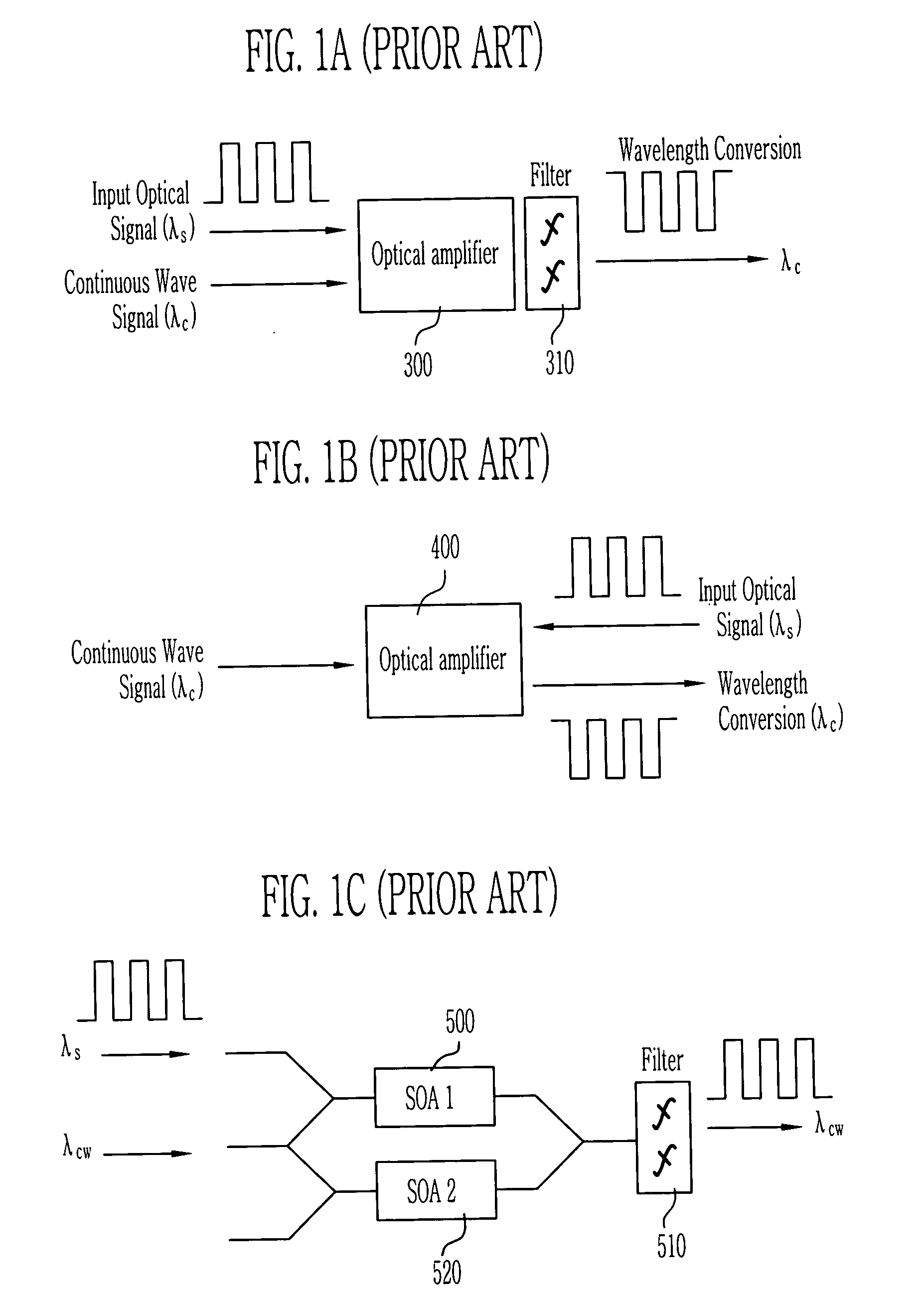Optical signal processing element using saturable absorber and optical amplifier
a technology of optical amplifier and optical signal processing element, which is applied in optics, electromagnetic transmission, instruments, etc., can solve the problems of large number of channels used, high power of input optical signal, and very restricted input optical power dynamic range, so as to improve output optical power and eliminate noise. , the effect of improving the extinction ratio
- Summary
- Abstract
- Description
- Claims
- Application Information
AI Technical Summary
Benefits of technology
Problems solved by technology
Method used
Image
Examples
first embodiment
[0028] (First Embodiment)
[0029] FIG. 2 is a constructional view illustrating an optical signal processing element according to a preferred embodiment of the present invention. The optical signal processing element comprises a saturable absorber 100 and an optical amplifier 110. FIG. 3 is a longitudinal view illustrating an example of modulating the optical signal processing element in FIG. 2.
[0030] Referring to FIG. 3, the optical signal processing element comprises a saturable absorber area 16a and an optical amplifier area 16b. Upper metal electrodes 14a, 14b are electrically disconnected correspondingly to the saturable absorber area 16a and the optical amplifier area 16b, respectively, and a lower metal electrode 15 is formed all over the saturable absorber area 16a and the optical amplifier area 16b. That is, the optical signal processing element comprises a undoped-doped InGaAsP group active layer 11, a p-doped InP cladding layer 12, an InGaAs ohmic contact layer 13, the upper...
second embodiment
[0040] (Second Embodiment)
[0041] Now, a second embodiment of the present invention will be described with reference to FIG. 5. FIG. 5 is a constructional view of the optical signal element according to the second embodiment of the present invention. According to the second embodiment of the present invention, as shown in FIG. 5, saturable absorbers 200, 220 may be integrated at both ends of the semiconductor optical amplifier 210. By means of this configuration, it is possible to minimize the noise by reducing the amplified spontaneous emission (ASE) noise generated in the optical signal processing element. In this case, it is preferable that the transparent output optical power of the first saturable absorber 200 is higher than the saturation input optical power of the optical amplifier, and the transparent input optical power of the second saturable absorber 220 is lower than the transparent input optical power of the first saturable absorber 200.
third embodiment
[0042] (Third Embodiment)
[0043] Now, a third embodiment of the present invention will be described with reference to FIGS. 6 and 7.
[0044] FIG. 6 is a constructional view of the wavelength converter fabricated using the saturable absorber integrated optical amplifier. The wavelength converter according to this embodiment comprises a saturable absorber 600, an optical amplifier 610 and a filter 620. Now, the operational principle of the wavelength converter will be described with reference to the FIGS. 7A.about.7F. In FIG. 7A, .lambda..sub.c indicates a desired wavelength of the continuous wave, and P.sub.tr indicates the transparent input optical power of the saturable absorber. In FIG. 7B, .lambda..sub.s is indicates the modulated input optical signal. In this case, when both of the modulated input optical signal having the wavelength .lambda..sub.s and the continuous wave signal having the desired wavelength .lambda..sub.c are inputted to the saturable absorber, the modulated input...
PUM
| Property | Measurement | Unit |
|---|---|---|
| wavelength band | aaaaa | aaaaa |
| transparent | aaaaa | aaaaa |
| optical saturation | aaaaa | aaaaa |
Abstract
Description
Claims
Application Information
 Login to View More
Login to View More - R&D
- Intellectual Property
- Life Sciences
- Materials
- Tech Scout
- Unparalleled Data Quality
- Higher Quality Content
- 60% Fewer Hallucinations
Browse by: Latest US Patents, China's latest patents, Technical Efficacy Thesaurus, Application Domain, Technology Topic, Popular Technical Reports.
© 2025 PatSnap. All rights reserved.Legal|Privacy policy|Modern Slavery Act Transparency Statement|Sitemap|About US| Contact US: help@patsnap.com



